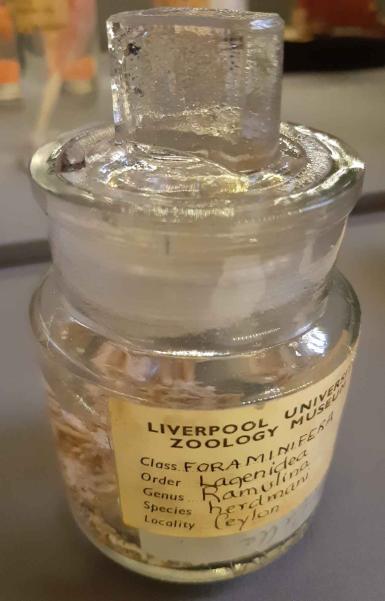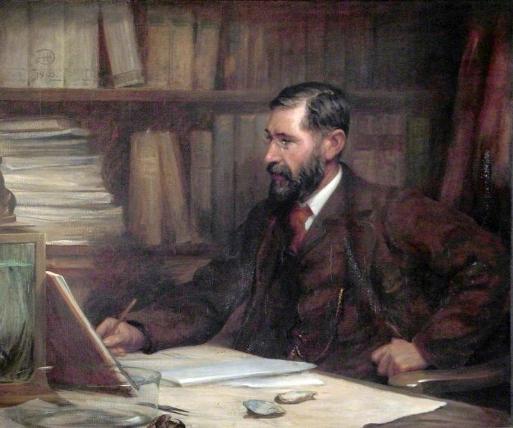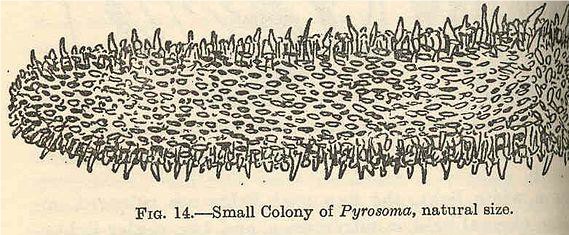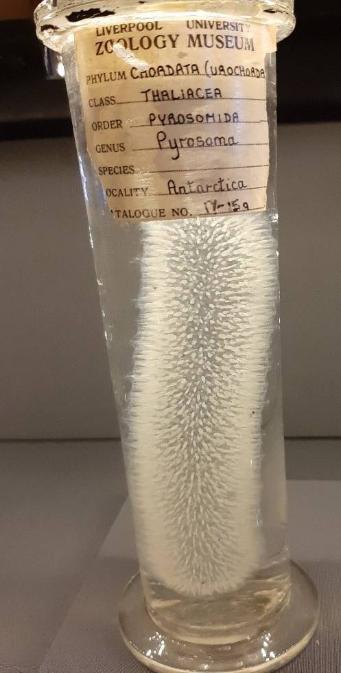What's in the Box?
Posted on: 7 August 2020 by By Lorna Sergeant Collections and Exhibitions Officer in 2020
.jpg,lead,.jpg)
Sometimes the smallest of objects can tell a big story. This unexceptional little box is one of them. This box holds an important but minuscule marine specimen. It also tells the story of a 19th century eminent marine biologist who built the foundations of the study of oceanography here at the University of Liverpool. That's a lot for a small box!

This specimen is Class: Foraminifera, Genus: Ramulina, Species: Herdmani found in Ceylon (Sri Lanka) and came from an expedition on the University’s first research vessel, the steam yacht Ladybird, run under the guidance of Professor William Herdman – a renowned marine zoologist and oceanographer. The specimen itself is actually part of the type specimen* of the marine invertebrate Rhabdocynthia ceylonica – first described by Herdman in 1902 during his work in Ceylon (Sri Lanka), and subsequently named after him. Herdman describes in his report:-
"In the morning I visited Aripu Coral Reef in one of the boats, and waded over parts of it. It was very rich zoologically, the eoral growth being exceedingly luxuriant. The most prevalent forms were : several species of Mddrcpora, Mohtipord, Turbinaria, Goniastrakt, Favia and Poritks. Large Cyprcea tigris, large Ascidia sp., a pinkish Rhabdocynthia, Cynthia sp., Euryfhoe latissim'a, E. hngicirra, Notodirus triyonoccphalus, and some Holothurians (including Holothuria moiuu-ariu)"
* the specimen that was originally used to name a species or subspecies or that was later designated as the basis for that name.
Herdman had found an ascidian otherwise known as a sea squirt. Sea squirts are more scientifically known as tunicates or ascidians, as they belong to the Class Ascidiacea. Sea squirts attach to things like piers, docks, boat hulls, rocks, and shells, many in subtidal locations. They may attach singularly or in colonies. Sea squirts are related to verterbartes because they have a notochord (a primitive backbone).

An example of a wet specimen of Class: Foraminifera, Genus: Ramulina, Species: Herdmani found in Ceylon (Sri Lanka)
So, who was he?

Professor Sir William Abbot Herdman (1859–1924), DSc, LLD, FRS, FLS, Chair of Natural History, University of Liverpool (1881–1919) by Robert Duddingstone Herdman (1863–1922)
William Herdman was Liverpool’s first professor of Zoology and Oceanography, and although too young to go himself, he worked on the publication of the Challenger Expedition a voyage (1872 -1876), that created the foundations of modern Oceanography. This data is still relevant in science today - for example - in the study of climate change. Herdman took as his special study the Tunicates, a group of marine organisms that includes salps and sea squirts, on which he became a leading authority. Herdman founded the zoology and geology departmental museums, which are especially rich in the representation of comparative anatomy and evolutionary discoveries.

Drawing by William Herdman

Pyrosoma, are free-floating colonial tunicates that today usually live in the upper layers of the open ocean in warm seas, this was found in Antarctica.
Herdman was passionate about the sea, his long-term aim was to bring scientific studies of the sea and apply them to the practical problems of the fishing industry. This became his life's work. In October 1920 he wrote in The Scientific Monthly, Vol. 11, No. 4
“The principles and discoveries of science apply to aqui- culture no less than to agriculture. To increase the harvest of the sea the fisheries must be continuously investigated, and such cultivation as is possible must be applied, and all this is clearly a natural application of the biological and hydrographical work now united under the science of oceanography.”
In 1885, with support from the local scientific community, he founded the Liverpool Marine Biology Committee, which two years later opened a research laboratory at Puffin Island, off Anglesey. Herdman's enthusiasm inspired many amateur naturalists besides his own students, and led to a series of publications on the fauna of Liverpool Bay and the Irish Sea.
In 1892 the station was moved from Puffin Island to a more advantageous position at Port Erin, Isle of Man, where it was later rebuilt to meet the growing demands of the university’s research students and continued to facilitate research until 2006. This includes the work of Professor Richard Thompson OBE who, during his 1996 PhD research at Port Erin, first spotted the problems of micro-plastics entering the seas and the marine food chain.
The study of the oceans dates back to 1919 when the University established the country’s first ever Chair in Oceanography through an endowment by Sir William and Lady Jane Herdman. Today the University of Liverpool hosts one of the sites of the UK’s National Oceanography Centre and the British Oceanographic Data Centre. Here the School of Environmental Sciences staff and researchers collaborate on a number of large research projects.
Herdman’s obituary in Nature (2857, 114, 02 August 1924) stated that:
‘Sir William Herdman’s life, if it is ever written, will be an inspiration to every man, whether he is interested in science or not.’
The legacy of Professor Herdman and the study of the oceans continues to live on. Who would have thought one small box and one tiny specimen would hold such a huge narrative? You can see more of this fascinating collection in the exhibition Under the Sea in the Tate hall.
Keywords: Oceanography, Sea Squirts, Foraminifera, The Challenger Expedition (1872 – 1876), Tunicates, Museum.